Paul Taylor’s American Modern Dance is inaugurated at Lincoln Center (March 11-29).
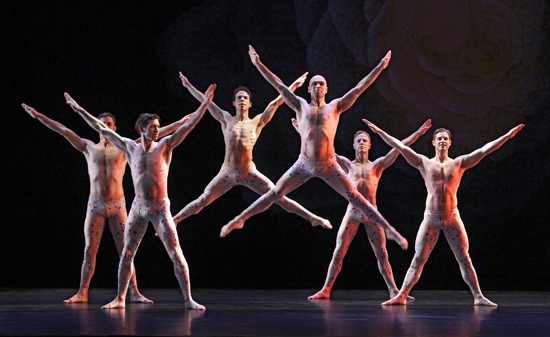
The six men of Paul Taylor’s Arden Court (L to R): James Samson, Sean Mahoney, Francisco Graciano, George Smallwood, Michael Trusnovec, and Michael Apuzzo. Photo: Paul B. Goode
Programming Paul Taylor’s new-to-New-York Sea Lark between his profoundly beautiful Arden Court (1981) and the equally gorgeous Esplanade (1975) during the Taylor company’s Lincoln Center season seems hardly fair to a piece that has little more in mind than a beach romp. You almost want to inquire, “Who let that perky, scrappy thing in to join the feast?”
Sea Lark comes with the expected credentials: set and costumes by the artist Alex Katz, lighting by James F. Ingalls, and Taylor’s wonderful dancers. The music has been excerpted from the score that Francis Poulenc composed for Bronislava Nijinska’s 1924 Les Biches (excluding sections of the original that involved singers). On March 11, the audience also had the supreme pleasure of hearing the music for all three dances played live by the Orchestra of St. Luke’s, conducted by Donald York.
Poulenc’s music, however, was made to fit the somewhat surreal atmosphere of Nijinska’s ballet. Its ambiance often changes suddenly and unpredictably from that of a parade ground or a circus to, say, a jazz club, or an afternoon tea dance, or a dreamy serenade by the sea. It careers crazily in Sea Lark—hardly hand-in-glove with the fun-and-games of Taylor’s work.
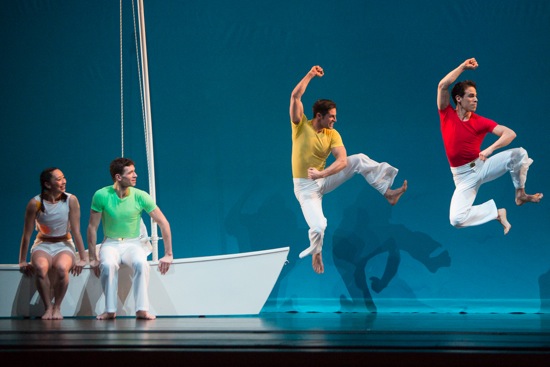
Paul Taylor’s Sea Lark. Christina Lynch Markham and Sean Mahoney watch Michael Apuzzo (L) and Francisco Graciano. Photo Yi-Chun Wu
I realize, on reflection, that “scrappy” is the wrong word to describe Sea Lark’s atmosphere; everyone in this dance is out to have a good time, but not a rowdy one; rivals do not face off; forever-love doesn’t raise its nose to sniff the air. This is not Spring Break.
The first several dancers appear on their bellies, “swimming” along furiously behind a low, bright-blue cardboard wave in front on a butter-yellow sky. A small white sailboat, with a mast about twelve feet tall, appears in the channel. Francisco Graciano walks it along, while Parisa Khobdeh lounges on its little deck, ready to hold her nose and slip into the briny deep. Which she does, but she’s also some kind of beach nymph—jumping and turning cartwheels and back flips.
The dancers in their almost fluorescently bright recreation attire romp in various asexual ways; soon the blue wave and the yellow drop lift, leaving only clean, fresh lighting and a glowing blue sky. The boat is still navigable however, and I’m tickled by the fact that whoever climbs aboard and is sailed along gazes toward an offstage horizon with the look of a person pursuing a noble dream.
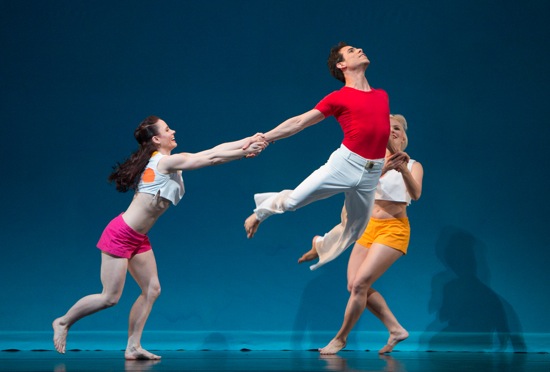
Eran Bugge (L) and Aileen Roehl at play with Francisco Graciano in Taylor’s Sea Lark. Photo: Yi-Chun Wu
Taylor has invented athletic games for two, three, or four. Sean Mahoney partners a bright, recent company recruit, Christina Lynch Markham. George Smallwood pairs up briefly with Jamie Rae Walker and Khobdeh with Michael Novak. The most pleasing sequence is a roguish encounter featuring Graziano, who is unwilling to choose between two small, bouncy best friends (Eran Bugge and Aileen Roehl). The three form amicable tangles, and Graciano squires or watches the pretty creatures, whipping off somersaults to impress them. His attentiveness to the moment gives the trio a great deal of its charm.
Eventually, all ten dancers form an appreciative, minimally moving chain in the background, while various ones emerge from the line to entertain and be applauded. Every person and every duo knows a trick or two. All of the participants can kick up their heels (literally) and goad their feet into a hornpipe of sorts. A woman’s rolling attack via somersaults can make a guy back away —more in admiration than in fear. These athletic folks can squat and hold their weight on one hand and kick their legs out. Michael Apuzzo flexes his biceps periodically, in case we haven’t realized how strong he is.
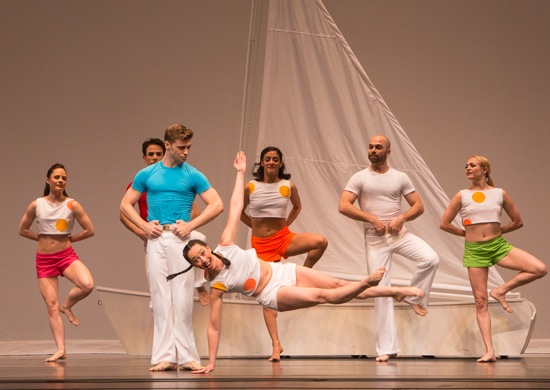
Michael Novak watches Christina Lynch Markham. At back (L to R): Eran Bugge, Francisco Graziano, Parisa Khobdeh, George Smallwood, and Jamie Rae Walker in Paul Taylor’s Sea Lark. Photo: Yi-Chun Wu
There were two intermissions on the evening that Sea Lark made its New York debut. Not only did these serve to refresh the dancers; they helped us move from the rich depths of Arden Court to Sea Lark’s superficial attractions and from there to the last dance, Esplanade. We came to that masterwork so hungry that people broke into applause the instant the curtain rose and Bach’s Violin Concerto in E Major sounded out.
Kate Geis’s revealing 2014 film, Paul Taylor: Creative Domain, shows the choreographer at work with his dancers on his Three Dubious Memories (2010). As I remember, one of the remarks he makes (many of which take the form of asides to Geis’s camera) expresses how wearisome it can be to have to create two new dances a year for his company. Not that he doesn’t get interested in the project once he gets going—that’s clear. But you can see that, in his eighties, with 142 dances to his credit, he might feel like getting out from under that responsibility. That—and planning his legacy—may lie beneath his plan to rename his enterprise Paul Taylor’s American Modern Dance and invite other choreographers to contribute work. (In the coming two weeks, Doris Humphrey’s 1938 Passacaglia, performed by the José Limón Company, and Shen Wei Dance Arts in Shen’s Rite of Spring share bills with Taylor’s choreography).
However, for this season’s three-week banquet, during which many of his own greatest works are programmed, Taylor has, per usual, offered his New York fans a second new piece —this one a world premiere. Death and the Damsel is somewhat more nourishing and more expensively tricked-out than Sea Lark. Santo Loquasto has provided three backdrops, in addition to marvelously bizarre costumes. The lighting is by James F. Ingalls, and the music is Bohuslav Martinů’s Sonata No. 2 (played by pianist Margaret Kampmeier and cellist Myron Lutzke).
It is probably entirely accidental that Taylor, tired from his demanding role as the creative force behind his company, makes the protagonist of this nightmarish piece a saucy young girl who is asleep when the curtain goes up and again as it’s about to go down. The program appends a brief quote below the title: “The City is of Night, perchance of Death.” This comes from the 18th-century Scottish poet James Thomson’s very long and gloomy opus, “The City of Dreadful Night,” which speaks of “. . .deadly weariness of heart all day” and goes on to this:
“But when a dream night after night is brought/ Throughout a week, and such weeks few or many/ Recur each year for several years, can any/ Discern that dream from real life in aught?”
I’m wondering if Taylor’s gloss on these and related images has something to do with how puzzling the dance is when you start to think about it. Does the heroine (wonderfully danced and acted by Walker) wake up cheerily to a bright morning in her garret apartment and then begin to feel a bit under the weather, become shadowed, then attacked by ghostly diabolical revelers? Or does she dream the whole nasty series of events, including her original waking up?
Each scene ends with a blackout, and each new one begins with dancers in the same pose but in a different setting: from the lop-sided apartment to an equally askew “Dance Club” to a cityscape dominated by a tilting, hallucinatory Chrysler Building. The sunshine-y young woman stretches happily, smooths her blanket, plumps her pillow, and dances blithely. An innocent newcomer to New York? Then people in fabulously strange, black-leather-and-lace outfits begin passing through and congregating. They’re glamorously creepy—crouching, crawling, slithering— and lustful within their own little community. Their eyes look out of black pits. The girl begins to feel uncomfortable, ill, and off balance; her initially expert cartwheels become bent-kneed excuses. The room turns red, and her bed is no safe refuge. Michael Trusnovec throws her dear little pillow offstage.
He’s her partner in the Dance Club, immobilizing her, his face in her neck, while others dance (they become motionless while he dances fiercely with her). Can she escape? No. She’s lying inertly on her back, feet toward the audience, when he pulls her legs up and then yanks them apart. Can you picture this horrid, clinical-but-crude stylization of gang rape, as man after man makes the same move—not touching Walker in any other way, just opening her legs and staring at what’s between them or looking straight toward us?
Then everyone punches and kicks her.
When the setting changes to display the Chrysler Building, she’s nose-to-nose with Laura Halzack, who attempts to choke her and pulls her around by her hair. But do not despair. As the others play slowly in the background, Walker gradually gets her wind back, as well as the strength we never knew she had. New York can open a girl’s eyes. Reader, she kicks and punches them until they crash to the floor and crawl away like the phantoms that they are. Then she goes to sleep and wakes up all over again. Looking puzzled. And well she might, because her bed has disappeared. (This is not an opening-night error; it’s Taylor being even more ambiguous than I imagined). All praise to the dancers (including Robert Kleinendorst, Michelle Fleet, James Sansom, Heather McKinley, Michael Novak, Lynch Markham, and Smallwood), who join in the hellish carryings-on with glee, as if there were an ongoing competition leading to a Most Depraved award.
Arden Court is being performed only twice during the season of Paul Taylor’s American Modern Dance season (the March 28th matinee is its last appearance). What a buoyant, fragrant work it is! And how beautifully it accords with music excerpted from William Boyce’s 18th-century symphonies. The fragrance is not just the one implied by the huge, almost translucent pink rose that almost fills the backdrop (set and costumes by Gene Moore). In two of the duets that materialize, one dancer is drawn to another the way a bee or a hummingbird is drawn to a blossom.
Wondering whether Taylor’s title was a reference to the Forest of Arden in Shakespeare’s As You Like It, I came across a poem that’s part of an earlier play by Thomas Lodge that Shakespeare drew on for his plot. “Rosalind’s Madrigal” opens with these lines: “Love in my bosom like a bee/ Doth suck his sweet;/ Now with his wings he plays with me,/ Now with his feet./ Within mine eyes he makes his nest,/ His bed amidst my tender breast. . . .”
This comes to mind as I watch Sean Mahoney moving slowly across the stage; as smoothly and serenely as in a dream, he balances on one leg, revolves, bends, steps out again. So immersed in his own thoughts is he that he doesn’t notice the enthralled woman (Roehl in a wonderful performance) fluttering around him, stepping over his bent thigh, squatting to scuttle under his lifted leg, perching on his back. The contrast between his self-absorption and her rapid encirclings is entrancing, and the moment when he finally sees and acknowledges her devotion strangely moving. In a later duet, it’s the man (Graciano) who can’t stop bounding and flitting about, while Khobdeh is more stately—appraising his busy ardor, not minding if he jumps over her leg when she’s resting.
Arden Court is among Taylor’s most ravishing blithe dances—ones in which leaps look like expressions of joy rather than displays of virtuosity, and people treat each other with tender interest. Esplanade has those qualities, although it’s more boisterous, more reckless. Taylor premiered it in 1975, a year and a half after he collapsed onstage during a performance of his American Genesis. I like to think Esplanade represents his getting his legs back in more ways than one. To Johann Sebastian Bach’s Violin Concerto in E Major and the Largo and Allegro movements from his Double Concerto in D Minor, nine dancers turn pedestrian movements into poetry. They stroll, walk, pace, march, scamper, run, race, bound into the air. They also fall down, roll on the floor, leap into each other’s arms, and rest. The esplanade on which this frank, open-hearted dance takes place is surely one by the sea or a river, where people promenading feel fresh breezes on their faces.
The enigmatic second movement, in which what appears to be a family crisis is enacted with small, mute gestures; the way the other dancers crawl slowly onto the stage after this, like exhausted animals making their way home; the moment in the gentle fourth section when Bugge steps lovingly onto Trusnovec’s belly as he lies on the floor and later walks up his reclining body as if placing her feet on a mountain path—in beautifully formed images such as these, Taylor reveals the shadows that the sun inevitably casts on a bright day. As in past years, the dancers “perform” more overtly than dancers in years past—wanting, in the happy parts, to show us what a good time they’re having together. Lovable as they are and as gifted, their excessive desire to interpret occasionally blurs the timing and shape of the movements.
The deep-hearted Beloved Renegade (2008), which opened the program on which Death and the Damsel made its debut, is a more austere piece than either Arden Court or Esplanade. An homage of sorts to the poet Walt Whitman, it has a few joyous moments and a great many mournful or tragic ones, as does the music that accompanies it: Poulenc’s Gloria (sung by St. George’s Choral Society, with Devon Guthrie offering the limpid soprano solos). Kleinendorst, Graciano, Walker, Roehl, and Michelle Fleet provide the most light-hearted scene, romping like children without “acting” childishness. Kleinendorst and Khobdeh splendidly convey ecstatic young love in a duet tagged “I sing the body electric.”
Whitman was not only a poet who embraced nature, he also did volunteer work in hospitals during the Civil War. Many were the deaths he attended. Taylor’s choreography shows us the central figure (a beautifully eloquent and restrained performance by Trusnovec) in relation to the wounded and dying soldiers who struggle onto the stage. Sometimes he and they form tableaux that resemble heroic, commemorative sculptures.
His relationship to two women is more enigmatic than that to the men he embraces and lays to rest. Lynch Markham dances attentively with him, like a partner or perhaps a stand-in for the male lover Whitman referred to in his 1865 poem “When Lilacs Last in the Dooryard Bloom’d.” Halzack surely represents the “strong deliveress,” she of “the sure-enwinding arms of cool-enfolding death.” She dances as the leader, the mother, the nurse, and the angel who, in the end, delivers a welcome death to the poet himself, after he has said farewell to all that he loves.

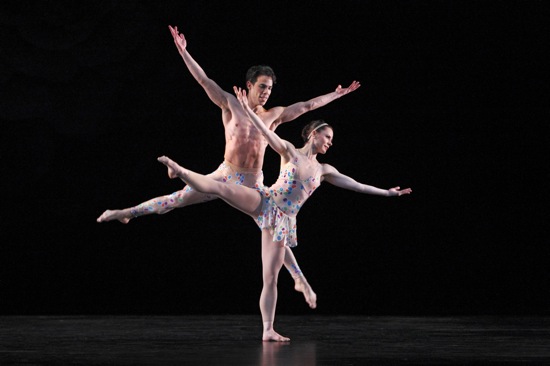
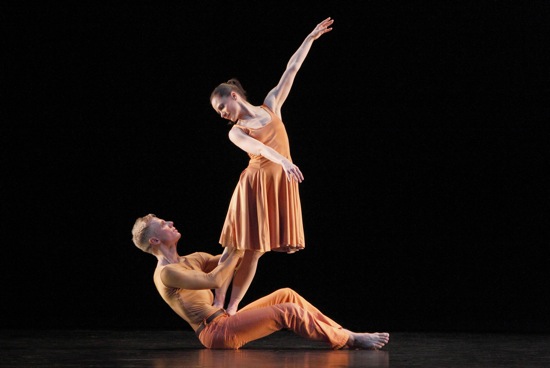
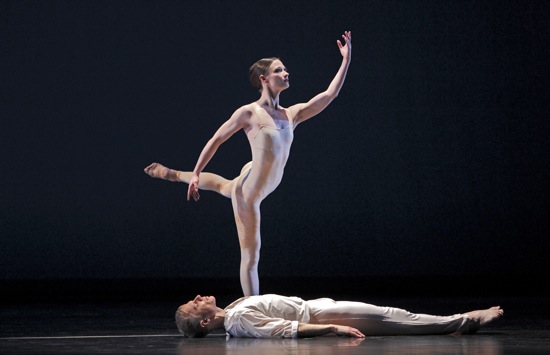
Hi, Deborah.
I thoroughly enjoyed your piece about Paul Taylor’s season. I’m working out of town, so I couldn’t see the performances. However, your writing is so eloquent and beautifully detailed that I felt as if I had been there. Thank you for your these postings and the gorgeous writing that continues to bring so much to so many.
All best,
Bill Whitener